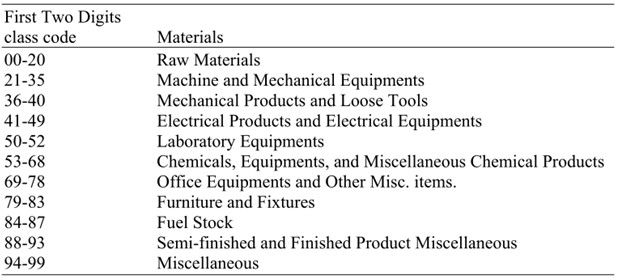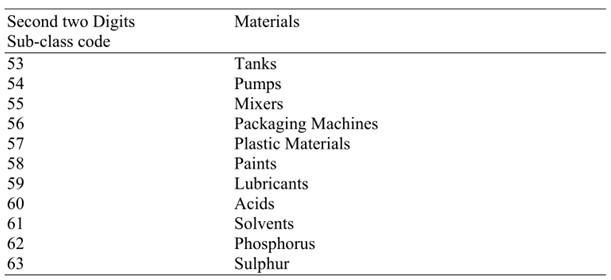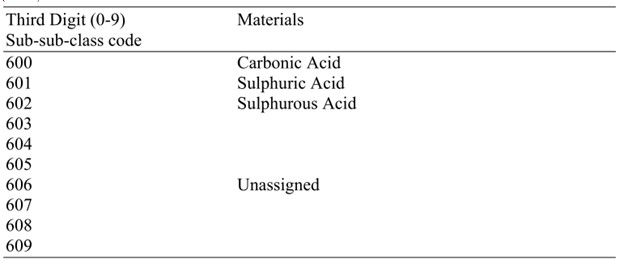From the above, it is clear that there must be some means of identifying the items accurately, uniquely, and adequately. These identification attributes are achievable by appropriate classification and codification. We are familiar with the PIN Codes used by Post and Telegraph Department to uniquely and concisely identify various regions of the country. Codification is a process of representing each item by a group of numbers and alphabets indicating the group, the subgroup, the type and the dimensions of the item. Many organizations in the private and public sectors, railways and DGS & D, have their own system of codification. The number of digits in a lode may typically be somewhere between eight and thirteen. The role of these digits and some fundamental principle of codification can be understood from the following example:
Digits 1-2 major group (raw materials, spare parts, subcontracted items, hardware items, packing material, tools, oil, stationery, etc.),
3-4 subgroup (ferrous, non-ferrous, etc.),
5-7 dimensional characteristics (length, width, head diameter, etc.),
8 minor variations,
9 location of storage
10-11 user departments of the organization,
12 products or product lines requiring the item,
13 any other information (related to inventory accounting, purchasing etc.).,
This is merely an illustration of codification, process. The codification process can be based on other aspects also. (i) The codes could be obtained by the nature of items in grouping all items. of the same metal content, say ferrous, non-ferrous etc. (ii) The system could be built sometimes on the basis of the end-use of items, say maintenance, spinning, foundry, welding, packing, machine shop, etc. (iii) The codification could be thought of on the basis of source of purchasing where items obtained from one source are grouped together. (iv)The codification could also be built on the basis of alphabetical listing.
Objectives of Codification
In order to identify the items correctly and logically for processing the transactions, and to facilitate easy location in stores, a codification system should be evolved with the following objectives:
Accurate and Logical Identification: A separate code is allotted to each of the items available in the storehouse indicating the size, quality, price, usability, special characteristics, specification, etc. This distinguishes one item from the other, even if nomenclature is the same, helps in accurate identification and eliminates any possibility of confusion. For example, a lead pencil of black colour, HB quality, for writing purpose and within a price range of Rs. 1.00-1.50 may have its code as
07.39.1236
Where 07 indicates the group (viz. stationery items)
3 indicates pencil,
9 indicates lead pencil,
1 indicates lead colour (viz. black)
2 indicates quality (viz. HB)
3 indicates use (viz. writing)
6 indicate price range (viz. Rs. 1.00-1.50).
Prevention of Duplication: All items are separately codified and are arranged in a logical order. Similar materials are grouped together (such as stationery items) and given a code (e.g., 07). Once a code is allotted to a particular group, it is a decision on an organizational level and in no case it is changed. Since each item has a different code number and various items are kept in different bins at different places, there can be no duplication in placing the orders, and no piling up of the materials will take place in the storehouse.
Standardization and Reduction in Varieties: For codification, grouping of identical items is done and it enables the stores to examine the entire range of items. It facilitates the elimination of those varieties in place of which other varieties of the like quality can be used; this reduces the number of varieties to the minimum. If proper standardization is achieved and the number of items is kept at the minimum, it will considerably reduce investment in various items as well as the cost of inventory carrying.
Efficient Purchasing: The filling up of purchase requisition, and preparation of purchase orders are simplified by the use of codes which easily indicate the materials required. Buying instructions to the suppliers become easy and quick if there is proper understanding of codification by the supplier. The entire operation of the purchase department can be organised according to grouping of items. In centralized purchasing such a system serves well in dealing with the purchase orders and in taking advantage of bulk purchasing.
Efficient Recording and Accounting: Codes lead to effective stock control, efficient recording and result-yielding accounting. Chances of mistakes are minimized. Pricing and valuation also become more accurate and reliable.
Easy Locating, Indexing and Inspection: The materials in the store have to be kept in an order which may facilitate their placement and location. For making it less time and energy consuming, items may be arranged according to the codes allotted to 1 them This would also facilitate a quick and efficient inspection.
Easy Computerization: Small size computers such as Personal Computers (PC) are finding their wide applications in materials management. The computers work better with codes than with long description of materials.
Essential Features of Codification System
There could be many possible arrangements of coding symbols (numbers, alphabets, etc.) which can be used to design a code. However, a great deal of thought must go into the coding scheme if it is to satisfy a variety of users. The following considerations must be kept in mind when designing codes.
Brevity: The codification system should avoid long and unwieldy description. This implies that the codes should consist of minimum possible number of digits. The size of the code would normally be dictated by the number and range of items and the number and types of applications of the data pertaining to the item. For example, for the pencil code 07.39.1236, the last digit representing the price range may be deleted if such information is not needed.
Logical: The coding system should be logically fit for the needs of the users and the methods of data processing employed. For the example of pencil code, the last digit representing price range should have an increasing price range with the value of the digit increasing, that is, a value of digit as 8 may indicate a higher price range of say Rs. 2.00-2.25.
Flexibility: The code design should be flexible to accommodate changes without disturbing existing codes. We are familiar with the library coding system in which codes do never get disturbed by addition of new books and all books to come in future are easily accommodated by the existing code structure.
Uniqueness: Each code must be a unique representation for the item it identifies. For example, an inventory item number or employee identification code must identify one and only one inventory item or employee.
Easy Understandability: The code structure must be easily understood by various users. It should be as simple, practical and meaningful as possible.
Proper Choice of the Coding Symbols: While a code may have numbers, alphabets or a mixture of both, certain precautions should be taken in selection of the symbols. Characters with similar appearances should be eliminated. For example, the letters 0, Z, I, S and V may be confused with the numbers O (zero), 2, 1, 5 and U, respectively. Where possible, letters that sound the same should be avoided (for example, B, C, D, G, P and T or M and N).
Layout of Codes: The layout of code should be equal in length. For example a code 001-199 should be preferred over 1-199. Codes longer than four alphabetic or five numeric characters should be divided into smaller segments for human judgments.
Capacity of a System: When calculating the capacity of a given code for covering all situations while still maintaining code uniqueness, the following formula applies: C=SP, where C is total available code combinations possible, S is the number of unique characters in the set, and p is the number of code positions. For example a 3-digit code with numbers 0 to 9 will have 103=1,000 unique code combinations. The size of code structure, therefore, should be decided before hand by anticipating the requirements of the unique combinations.
Codification Systems
There are several systems possible for codification of materials depending on the choice of coding symbols-alphabets, numbers, or a combination of alphabets and numbers (alphanumeric). Two popular and fundamental systems-Brisch and Kodak-are described here.
Brisch System: The Brisch system is based on numbers from 0 to 9 and consists of blocks (typically three) separated by decimal points. The blocks are assigned specific classification of the materials. The first (left most) block represents the major classification (such as raw materials, packing materials, finished materials, etc.), the second block represents the next level classification (such as nature, use, quality, characteristics, etc.) while the third block represents the lowest level classification (such as quality of the material, its components; its facial appearance, price, availability, source of supply, marketability, frequency of use, etc.). The following example for stationery items explains the Brisch system. The major item stationery is classified into four groups based on the nature of each item and each group in turn is divided into further subgroups.
| Item Particulars | CODES | |||
| Main | Sub code I | Sub code II | Full Code | |
| Stationery | 63 | |||
| Pencil | 01 | 63 01 | ||
| Pen | 02 | 63 02 | ||
| Paper | 03 | 63 03 | ||
| Ink | … | 04 | …. | 63, 04 |
| Pencil | … | …. | …. | |
| Black | … | …. | 41 | 63.01.41 |
| Blue | 43 | 63 01 42 | ||
| Red | 43 | 63 01 43 | ||
| Blue Red | 44 | 63 01 44 | ||
| Pen | ||||
| Ball-point | 51 | 63 02 51 | ||
| Fountain | 52 | 63 02 52 | ||
| Holder | 53 | 63 02 53 | ||
| Inkstand | 54 | 63 02 54 | ||
| Paner | ||||
| White | 35 | 63 03 35 | ||
| Brown | 36 | 63 03 36 | ||
| Typing | 38 | 63 03 38 | ||
| Duplicating | 39 | 63 03 39 | ||
| Ink | ||||
| Blue | 12 | 63.04.12 | ||
| Black | 14 | 63.04.14 | ||
| Red | 15 | 63.04.15 | ||
| Duplicating | 17 | 63.04.17 |
The system proceeds in the following steps:
- The materials to be coded are grouped together so as to form a major group. The grouping should be accurate and unambiguous, and should not overlap. It is based on the classification system described in the previous section,
- After the classification or preliminary grouping, the materials are further divided and sub-divided as explained earlier. The basis of these division and sub-division is described the materials in as great detail as possible and simultaneously making them relevant to the users.
- The codes are assigned in three blocks separated by decimal points. Total number of digit could be any as per convenience but a general figure is 7 (seven).
Kodak System: The Kodak system has been developed by Eastman Kodak Co. of New York, USA and is supposed to be a very comprehensive system. It consists of 10 digits of numerical code. The basis of the major or first level grouping is source of supply. All materials are divided into 100 basic classifications based on purchase and procurement considerations. For instance, a bolt is listed as hardware item if this is listed in hardware catalogues and available with hardware suppliers. If this bolt, however, is available only as part of the machine, it will be available under maintenance. Each class is divided into 10 sub-classes. For example, if class 20 represents cutting tool, then 200 represents drills, reamers, counter bars, etc. The steps of classification can be understood by the following example:
Step I: Major (First Level) Classification (based on purchase and procurement consideration)


Step II: Sub (Detailed) Classification of materials in class code say 53-68 (Chemicals, Equipments and Miscellaneous Chemical products).
Step III: Further Sub-classification indicating kinds in a particular sub-class of materials say 60 (acids).

Step IV: The kind of the materials may further be divided into different types. For example 601 indicating sulphuric acid may further be classified indicating the type of the sulphuric acid. For example, one may classify the types of sulphuric acid as,

This level has two digits while the previous level had only one digit. This is possible. There is no strict pattern to be followed about the number of digits and the level of the classification. The two digit code in Step IV indicates suitably the percentage of acid content.
The process of classification and sub-classification may continue to accommodate subsequent levels of variations. The code may have some digits left unutilized for future expansion. For example a code 601-87-XX XXX indicates chemical product (53-68 group) and in that acid (60), and in that sulphuric acid (1) and in that Type B (87). The digits XX-XXX are left for future expansion.
Colour Coding Systems: Sometime colour codes are used to identify the items. Common instances are, red, blue and green in an electric cable, red and green in electric switches, and so on. Some organization use the codes locally such as to identify the steam, water and other pipes while there exist some national or international colour coding system. The limited number of colours available narrows the scope. Nevertheless, this is quite an effective system providing easy Identification.

